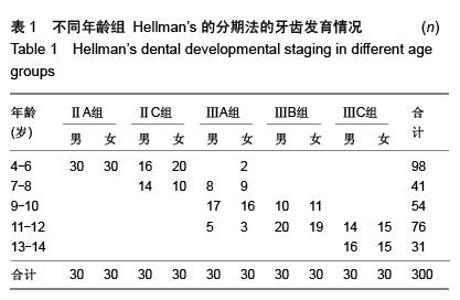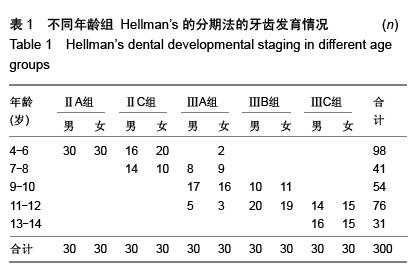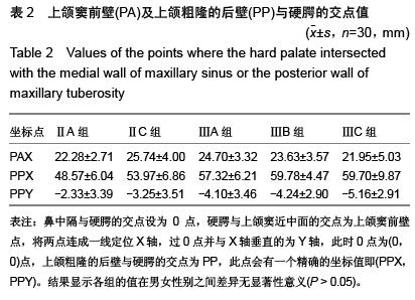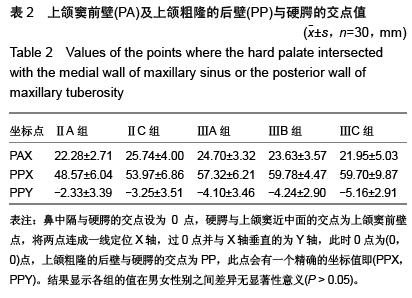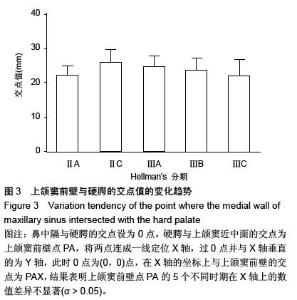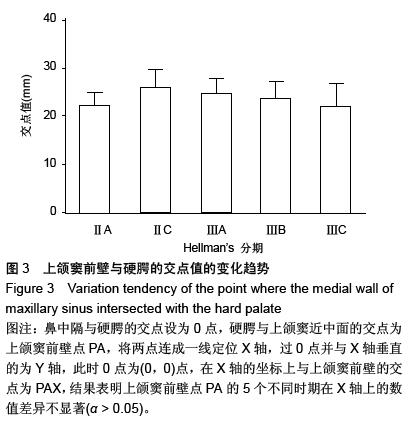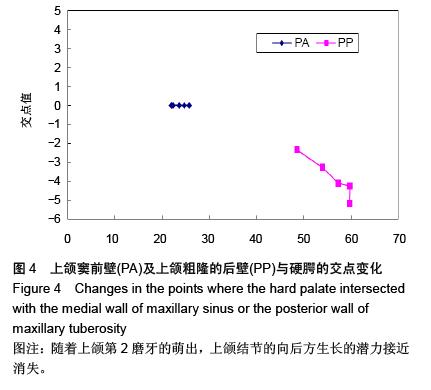| 1] Langford RJ, Sgouros S, Natarajan K, et al.Maxillary volume growth in childhood. Plast Reconstr Surg.2003;111(5):1591-1597.[2] Suda N, Hiyama S, Kuroda T. Relationship between formation/eruption of maxillary teeth and skeletal pattern of maxilla. Am J Orthod Dent Orthop.2002; 121(1):46-52. [3] Brin I, Camasuvi S, Dali N,et al. Comparison of second molar eruption patterns in patients with skeletal class II and skeletal class I malocclusions. Am J Orthod Dentofacial Orthop.2006; 130:746-751.[4] Weingart D, Bublitz R, Petrin G,et al. Combined sinus lift procedure and lateral augmenta-tion. A treatment concept for the surgicaland prosthodontic rehabilitation of the extremely atrophic maxilla. Mund Kiefer Gesichtschir. 2005;9:317-323.[5] Cha KS.Skeletal changes of maxillary protraction in patients exhibiting skeletal class III malocclusion: a comparison of three skeletal maturation groups. Angle Orthod. 2003;73(1):26-35.[6] Chiapasco M, Zaniboni M, Rimondini L. Dental implants placed in grafted max-illary sinuses: a retrospective analysis of clinical outcome according to the initial clinical situation and a proposal of defect classfication. Clin Oral Implants Res. 2008 ;19: 416-428.[7] Vardimon AD, Shoshani K, Shpack N,et al. Incremental growth of the maxillary tuberosity from 6 to 20 years-A cross-sectional study.Arch Oral Biol. 2010;55(9):655-662. [8] 韩培辉,丁寅,李永明,等.上颌结节在不同年龄阶段发育特征的对照研究[J].现代生物医学进展,2012.12(10):1889-1896.[9] 郭鑫,刘进.上颌第三磨牙缺失或拔除后上颌结节骨量的对照研究[J].临床口腔医学杂志, 2009,25(6):381-383.[10] Thomas A, Raman R. A comparative study of the pneumatization of the mastoid air cells and the frontal and maxillary sinuses. AJNR Am J Neuroradiol. 1989;10(5 Suppl):S88.[11] Anon JB, Routal M, Zinreich P, et al.Maxillary sinus anatomy Anatomy of the Paranasal Sinues.1996:18-21.[12] Ritter FN. The Paranasal Sinus-Anatomy and surgical Technique,ed2. St Louis: Mosby. 1978:6-16.[13] Peterson LJ.Contemporary Oral and Maxillofacial Surgery. ed2.StLouis: Mosby. 1993:465.[14] Tsai HH, Tan CT. Positional Changes of the Upper Canineand Posterior Teeth, Hard Palate, and Sinus Floor from Primary to Permanent Dentition.J Dent Child (Chic). 2004;71(1):48-53. [15] 傅民魁,贾绮林主译.当代口腔正畸学[M].人民军医出版社, 2007:3.[16] Gedrange T, Köbel C, Harzer W. Hard palate deformation in an animal model following quasi-static loading to stimulate that of orthodontic anchorage implants. Eur J Orthod. 2001; 23(4):349-354.[17] Mao JJ. Mechanobiology of craniofacial sutures. J Dent Res. 2002;81(12):810-816.[18] Southard TE, Franciscus RG, Fridrich KL, et al.Restricting facial bone growth with skeletal fixation: a preliminary study.Am J Orthod Dentofacial Orthop.2006;130(2):218-223.[19] Enlow D, Hans M. Essentials of facial growth. 1st ed. Philadelphia:WB Saunders. 1996:79-80.[20] Barghouth G, Prior JO, Lepori D, et al. Paranasal sinuses in children: size evaluation of maxillary, sphenoid, and frontal sinuses by magnetic resonance imaging and proposal of volume index percentile curves. Eur Radiol. 2002;12(6):1451-1458.[21] Jun BC, Song SW, Park CS, et al. The analysis of maxillary sinus aeration according to aging process; volume assessment by 3-dimensional reconstruction by high-resolutional CT scanning. Otolaryngol Head Neck Surg. 2005;132(3):429-434.[22] Buschang PH, Baume RM, Nass GG. A craniofacial growth maturity gradient for males and females between four and sixteen years of age. Am J Phys Anthrop.1983;61(3):373-381.[23] 陈莉莉,林久祥,许天民,等. 13-18岁汉族正常合青少年上牙弓后段科利用间隙变化的纵向研究[J].口腔正畸学,2007,14(1):25-28. [24] 张兴中,周彦恒,林久祥.北京地区13-15岁正常牙合个体面部垂直向生长的纵向研究[J].实用口腔医学杂志, 2006,22(4):460-464. |
